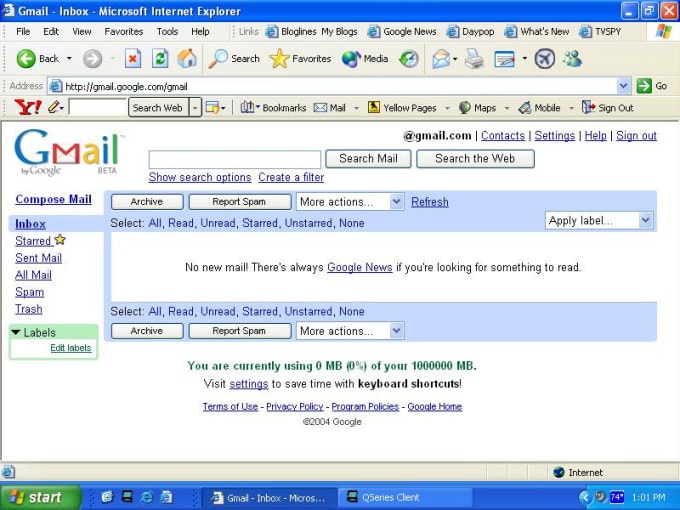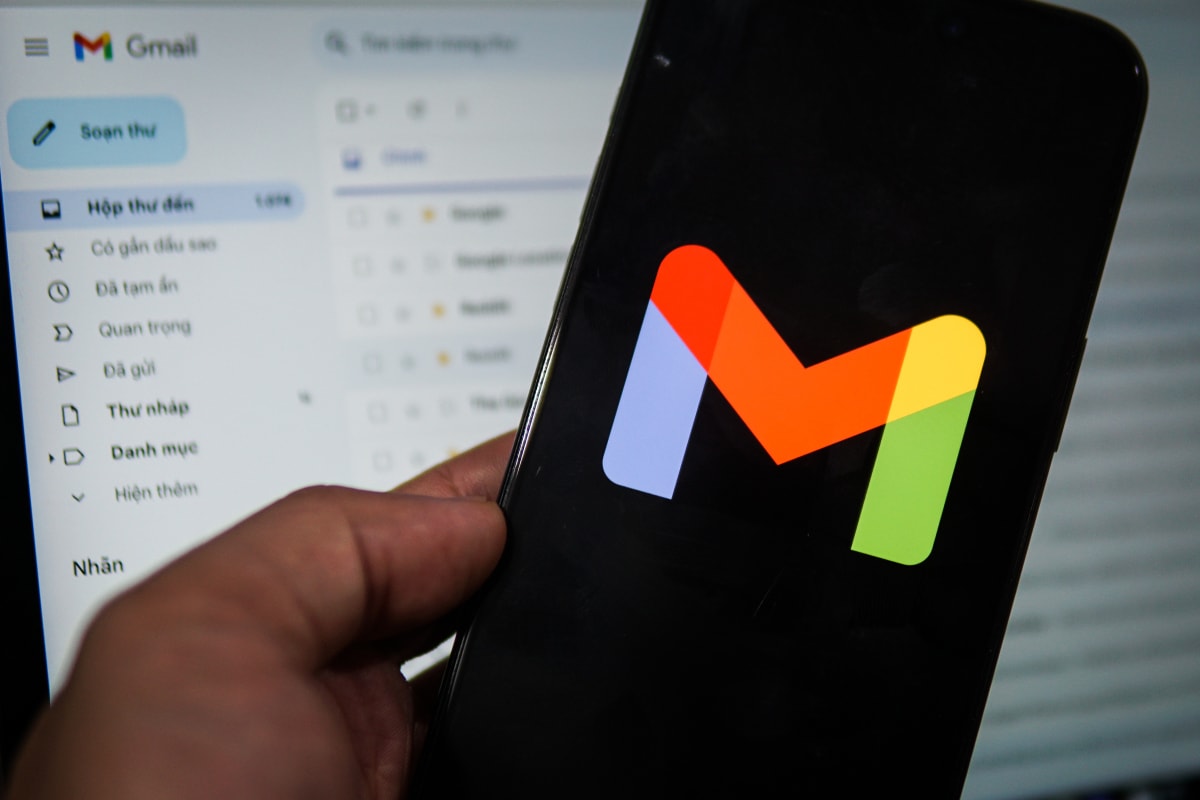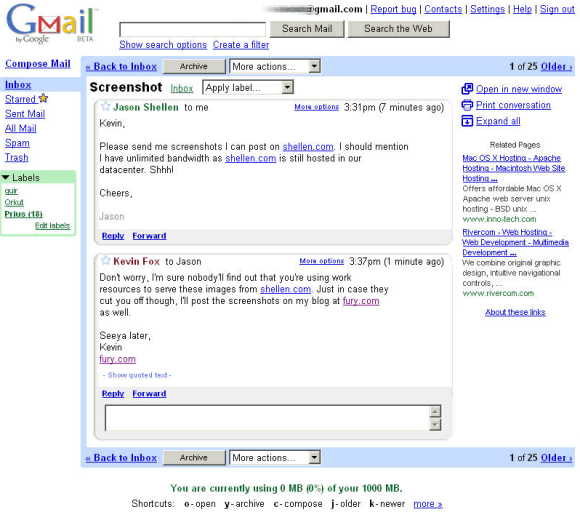Gmail was born on April 1, 2004 and many people thought it was an April Fool's joke by Google when it offered 1 GB of free storage, 100 times more than other services.

"Google gets the message", "search is the second online activity, email is number one", "free storage of 8 billion bits of information, equivalent to 500 thousand pages of email" were the opening messages of the press release Google released exactly 20 years ago.
The humorous writing and the "absurd" promise at the time made many people think it was a joke from Google - a six-year-old online search startup. Users also couldn't create Gmail, but had to sign up for a waiting list to experience the beta.
"A silly press release, released on April Fool's Day," said Victoria Song, a writer forThe Verge, recall. At that time, Yahoo and Hotmail were "making waves" and were the first names that users thought of when they needed to create an email. These services offered free storage of up to 15 MB. To receive more emails, users had to delete old messages or buy more storage. Meanwhile, Google announced 1 GB for free, emphasizing the word "per user".
But when people on the waiting list started using Gmail, they no longer thought it was a joke. After 20 years, the service launched on April Fool's Day has 1.2 billion users, equivalent to 1/7 of the global population.
From a Google engineer's side project...
According to Google's announcement at the time, the idea of Gmail came from users' complaints about email services, which made them spend a lot of time searching for a certain email as well as arranging their mailboxes to have enough space.
"She had to delete emails 'like crazy' to stay within the mandatory 4MB limit. She asked us if we could not fix this," said Larry Page, then Google co-founder.
This complaint caught the attention of some engineers. Google often asked employees to spend one day a week, or 20% of their time, working on a project that interested them, unrelated to their main job. Building an email service with good search capabilities was considered by some engineers to be a fascinating “20% project,” which led to the birth of Gmail.
“If Google users have problems with email, we have problems with it,” said Sergey Brin, Google’s co-founder and chief technology officer. He said that Gmail was “more complicated than we anticipated,” but that it was ultimately available to those who requested it.
The Gmail beta focuses on three pain points: the ability to quickly search for emails based on keywords; the ability to store 1GB of space, 100 times more than the average of its peers; and speed, as the service automatically sorts individual emails into conversations, similar to the current concept of "mail threads," rather than letting users sort them themselves.
However, even in the announcement, the two Google founders themselves did not fully believe in the service's success. "We will provide a test first with a small number of email enthusiasts. With luck, Gmail will become popular with them and the people who originally came up with the idea," the announcement said.
...to the passport to the Internet world
From a joke announcement, Gmail has grown in popularity. According to Victoria Song, having a Gmail account in 2004 was like the fastest ticket to the coolest group, even though many people didn’t need it.
In the memory of Rich Demuro, a technology reporter for a local newspaper in Louisiana (USA), Google was a "hot" name in the technology world thanks to its search engine and people had to line up to register to use it when Gmail was announced.
Gmail had a "clean" interface, often displaying advertisements between users' emails. This made many people suspect that the company was reading their emails to advertise. By May 17, 2004, Google had to send an email explaining to users that "all are scanned by computers and ads are placed automatically, no one reads your emails."
Twenty years later, free storage was increased to 15 GB. Gmail was almost ubiquitous on mobile devices.

According to Victoria Song, with enough storage capacity, Gmail is like an infinite record of her life, from emails with her parents when studying away from home, internship applications sent, cards from old classmates, even love stories shared via email.
“When I look back at old emails, I feel like I’m stepping back in time,” Song said. Many parents even create Gmail accounts for their newborns, both to keep their preferred username and to store their child’s information like a digital book.
Gmail is also increasingly embedded in users' Internet lives. When they use a service, their account will be linked to their email, or they can use Gmail to log in. When their account is locked, they also have to provide Gmail to get it back.
“Gmail is like a passport to the Internet. I may not be excited to open Gmail anymore, but my Gmail password is the most important password in my life,” Song said.
According to Ilya Brown, Vice President of Gmail, developers also realize that Gmail is now like an identity on the Internet, a representation of a person from the real world.
The Future for Gmail
Gmail is now a ubiquitous part of the Internet, but its role in communication has faded as messaging software has taken over.
Google's email service used to integrate Gchat, but it couldn't compete with Messenger, WhatsApp, Slack, Telegram today. Users used other messaging software, which meant more of their important data was stored there instead of Gmail like before.
The huge capacity to store every email used to be an advantage, but after 20 years, they accumulate a lot of spam emails, making users no longer excited every time they open an email.

“If you compare screenshots from then to now, Gmail has changed, but my inbox is largely the same as when I opened my account in 2004,” Demuro notes. “I get a lot more spam today.”
The developer confirms this. “What we value is building things that people need. With a product like Gmail, there are high expectations for reliability,” says Maria Fernandez Guajardo, senior director and product manager of Gmail. While the company is keen to experiment, Guajardo says, the company has to be careful about rolling out any new features and explaining how they impact the product.
Gmail is certainly here to stay, but the question of how users will interact with it in the future remains, according to Victoria Song. "Every day, we see our friends announcing that they are closing their social media accounts. But no one has said they are giving up email," Song writes.
HA (according to VnE)